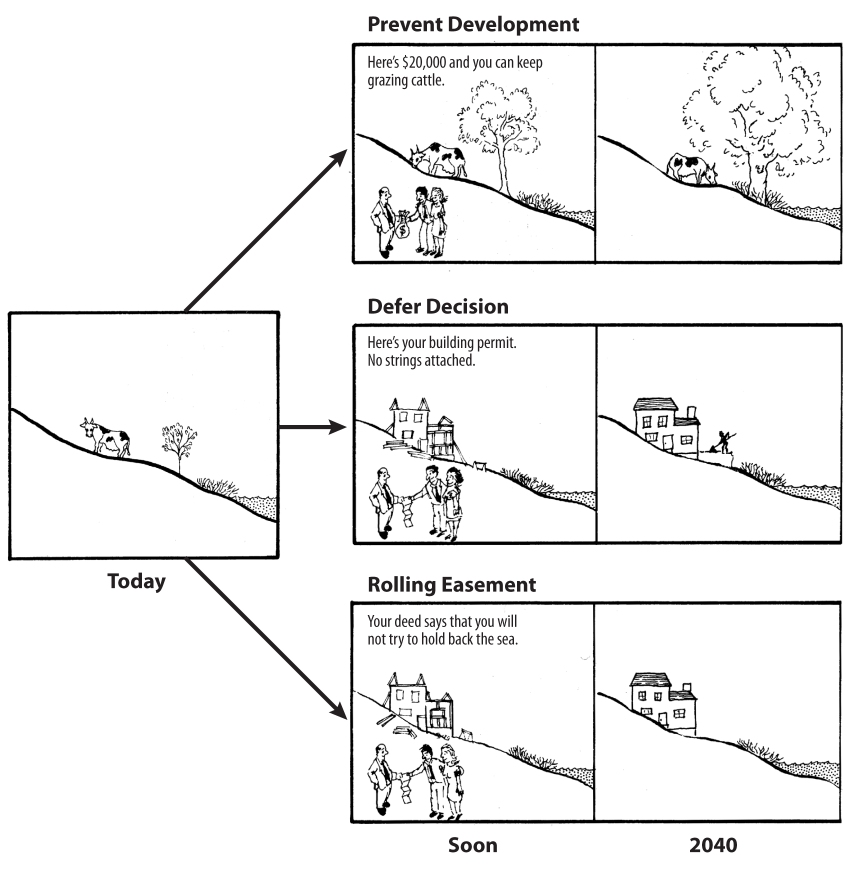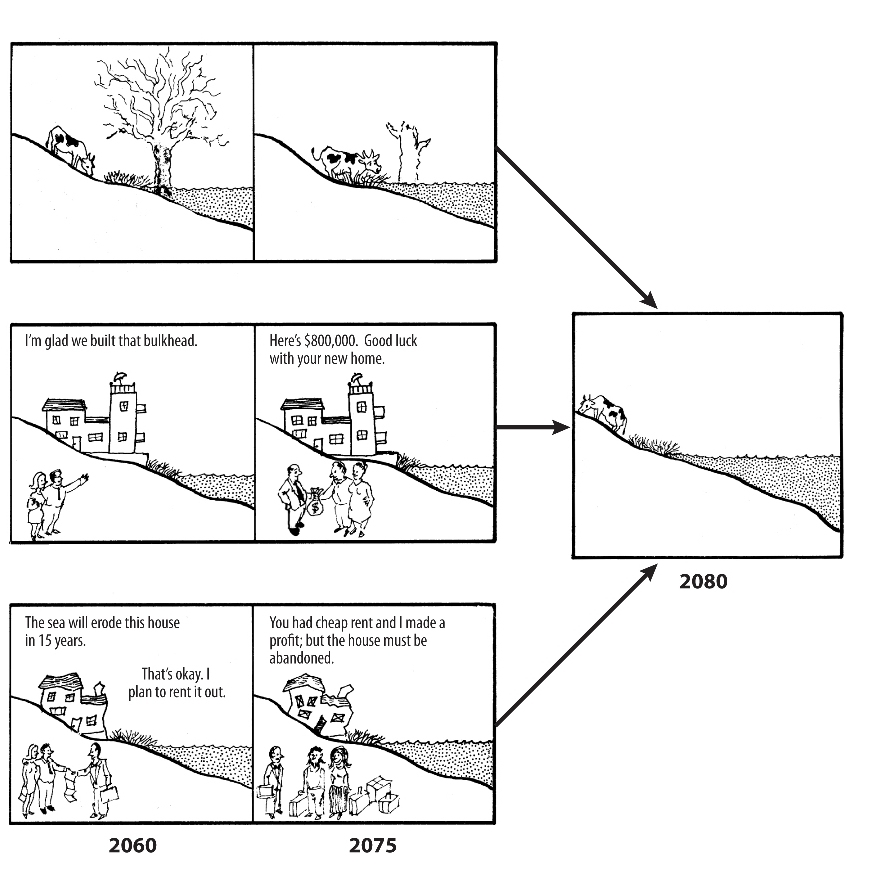- Causes of Future Sea Level Rise
- Elevation Maps
- Will we really lose all that land?
- Sea Level Rise Planning Maps
7.2 Where are Rolling Easements Preferable to Other
Measures for Ensuring a Retreat?
The three most commonly evaluated legal approaches for implementing retreat are (in decreasing degree of interference with private land use):
- Limit or prevent construction (setback);
- Rolling easements; and
- Curtail subsidies and rely on market forces (laissez-faire).
Figure 15 shows scenarios about how those options may play out over time, from the perspective of a single property owner. Figure 16 provides an aerial view that compares the initial restrictions associated with a setback policy to the later loss of homes resulting from a rolling easement policy.

|

|
Figure 15. Three Approaches to Ensuring That Wetlands Can Migrate Inland. In each case, the land starts and ends as vacant farmland. This figure assumes that the public rather than the property owner bears the cost. Under the Prevent Development approach, the value of using the land for development is signified by the upfront cost of buying a non-development easement. Under the Defer Action approach, it is ultimately necessary to buy the entire land and structure. With rolling easements, a house must eventually be abandoned as well, but the eventuality has been incorporated into the expectations of the owner, who forgoes renovations. The cartoon does not include the cost of purchasing the easement, because its present cost would be trivial enough that it could easily be included as a permit condition for building or subdivision. |
The setback approach is usually preferable if it is feasible, because rolling easements are more administratively complex. Maryland limits development to one home in 20 acres along most shores that had not been developed by the 1980s.[515] The low-density development makes shore protection relatively unlikely.[516] In un-developed areas where land slopes are steep, it may be possible to ensure that all buildable lots created by new subdivisions have a house site at least 15–20 feet above the tidal wetlands. Even there, a rolling easement would provide additional assurance that wetlands will be able to migrate inland; [517] but the policy that keeps the low land vacant makes retreat likely with or without the rolling easement. (The previous section considers whether vacant lands should be a high priority for retreat because rolling easements are more feasible, or a low priority because rolling easements might not be necessary.)
Relying on market forces may be effective in some locations. But rolling easement policies would generally be more effective wherever property values are greater than the cost of shore protection. Even where shore protection costs are greater, a rolling easement may be an effective tool for warning owners not to expect government-funded shore protection.
In most coastal states, no one can confidently predict whether a takings claim will succeed if a government policy forces people with homes along estuarine shores to abandon homes to the rising sea. Rolling easements may be a useful way to avoid or mitigate such claims.
- A purchased or donated rolling easement eliminates the risk of a successful takings claim because the government or easement holder compensates (or receives through donation) the interest that might otherwise be taken. Depending on how it is acquired, a rolling easement may require a small payment today—but that payment provides legal certainty in what would otherwise be an uncertain legal environment. [518] The fair market value of a rolling easement will be small, except possibly in cases where property loss is imminent.
- Obtaining a rolling easement as an exaction in a permitting process would usually—but not always—prevent a takings claim.[519] Regardless, it would provide legal certainty[520]because the takings claim would have to be litigated at the time of the exaction,[521]rather than decades hence when a home is threatened.
- A regulatory or legislative rolling easement can also mitigate the eventual takings claims. Laws that initially change property rights or prohibit shore protection become part of the background principles of property law sooner [522]or later,[523] and become part of the expectations of people who buy land. Thus, the takings claims are unlikely to be viable for land that changes ownership at least a few times between the day the regulation is issued and the day the property becomes threatened decades later. Clarifying the “rules of the game” could also mitigate eventual takings claims by providing landowners with increased certainty and thus reduce the possible harm from unpredictable regulatory requirements.
Finally, there may be several miscellaneous categories of land in a
given jurisdiction where rolling easements are most practical. Land that will be
created by accretion or avulsion in the future is water today, and hence it
should be relatively uncontroversial to issue regulations today that prohibit
private shore protection on these lands.[524]If such parcels ever become land, it will
be because shores were allowed to migrate. So ensuring that such processes
continue to operate would be analogous to the common law rule of accretion and
reliction, whose justification for awarding accreted land to the waterfront
landowner is that such an owner would also lose title to eroded
lands.[525] Similarly, when a government agency issues a permit to fill privately
owned wetlands for development, it could include a rolling easement as a permit
condition.[526] Another possibility is that whenever the government
transfers land to private parties, a rolling easement could be retained on the
lands.
[515] See supra notes 295–297 and accompanying text.
[516] See supra note 289.
[517] People may otherwise erect shore protection to keep their back yards..
[518] Here we are referring only to the uncertainty about a successful takings claims. It still may be possible to challenge either the creation of the rolling easement itself, see supra § 4.2.2, or its continuing viability, see supra § 8.2.
[519] See supra note 376. Davidson et al. point out that dedication of roadways and other conditions in return for subdivisions and rezoning has been upheld in several cases. Jonathan M. Davidson, Ronald Rosen-berg, & Michael C. Spata, Where's Dolan: Exactions Law in 1998, 30 Urb. Law 683, 684–85 (1998). Unlike those cases, the rolling easement has a common law nuisance basis as well. See U.S. v. Milner, 583 F. 3d 1174, 1190 (owner of tidelands below mean high water has legally recognized interest in shore protection).
[520] See supra note 535
[521] See supra note 380 and accompanying text.
[522] A law
that explicitly takes a property right may be a constitutional taking when
enacted, entitling landowners to just compensation based on the current market
value of what is taken. For a
parcel not likely to be threatened for a century or more, the just compensation
is likely to be trivial—especially in an undeveloped area where the economic
feasibility of eventual shore protection is unclear. See supra § 4.1.3.
[523] Before Palazzolo v. Rhode Island, 533 U.S. 606 (2001), courts and commentators generally accepted “the notice rule” under which a takings claim based on a regulation was—in effect—extinguished upon sale under the theory that activities prohibited by the regulation would not be among the property rights the owner has purchased, since he had noticed that the property did not include those rights; see Eagle, supra note 362, at 533–534 (2002). After Palazzolo, the takings claim does not instantly vanish upon sale. But the issue of shore protection may not be a fundamental property right similar to development (which arose in Palazzolo) or keeping a home already built (which arose in Severance v. Patterson) for purposes of the notice rule, because the state has a competing property interest in the public trust tidelands otherwise eliminated by shore protection. Statutory rights to shore protection may create an investment backed expectation that relies on shore protection; while a regulatory rolling easement would remove that expectation for subsequent purchasers of the land. Legislation that protects the migrating boundary while protecting the upland owner against a forfeiture could be adopted by courts as a reasonable balancing of the interests and thus become part of the title to coastal property through ordinary applications of nuisance law.
[524] South Carolina's setback rule generally prohibits development of land created by accretion or avulsion during the last 40 years. S.C. Code Ann. § 48-39-280. If a variance is granted (e.g., because otherwise a taking result) then any construction is subject to a rolling easement rule. S.C. Code Ann. §48-39-290 (D).
[525] See supra note 67 and Sax, supra note 65, at 308 (quoting Blackstone). The reasoning against the notice rule in Palazzolo (unjust enrichment of the government at the expense of the landowner who cannot sell his takings claim) would apply less (if at all) to land that did not exist when the rule was created.
[526] Such a permit condition would meet the Supreme Court's current standard for exactions. See supra § 4.2.1 for details on those standards. There is a very clear nexus between allowing someone to convert wetlands to dry land and requiring that eventually they allow natural forces to convert the dry land back to wetlands. If the permit condition only applies to the land that is filled, there is a strict proportionality, which more than meets the standard for rough proportionality.
This page contains a section from: James G. Titus, Rolling Easements, U.S. Environmental Protection Agency. EPA‑430‑R‑11‑001 (2011). The report was originally published by EPA's Climate Ready Estuary Program in June 2011. The full report (PDF, 176 pp., 7 MB) is also available from the EPA web site.
For additional reports focused on the implications of rising sea level, go to Sea Level Rise Reports.

 7.1 Where is retreat preferable to protection?
7.1 Where is retreat preferable to protection?